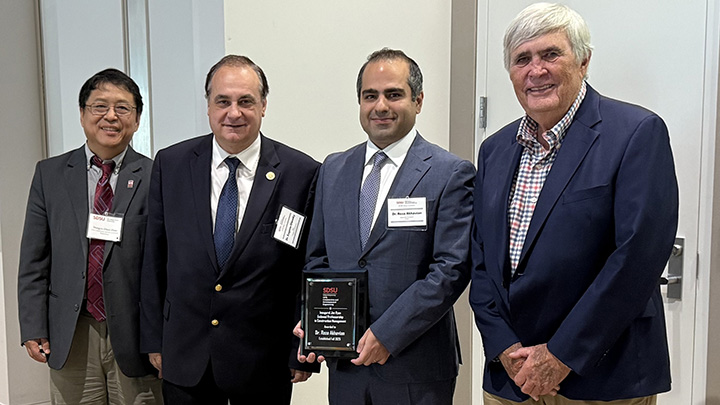Connecting the dots between national security and the ‘threat multiplier’ of climate change
Sherri Goodman, the Pentagon’s first-ever deputy undersecretary of defense for environmental security, launches the Uechi ISCOR lecture series, 4:30 p.m. Nov. 20 at the Conrad Prebys Aztec Student Union Theatre.

It was 2007 when Sherri Goodman, the Pentagon’s first deputy undersecretary of defense for environmental security, coined the phrase “threat multiplier” to define how climate change intensifies pre-existing security threats by making them worse.
Today the concept is taught in San Diego State University’s International Security and Conflict Resolution (ISCOR) courses. And a new lecture series is bringing Goodman to campus for a wide-ranging conversation about climate change, environmental security issues and the ideology surrounding these topics.
The Uechi ISCOR Lecture will be held 4:30-5:30 p.m. Thursday, Nov. 20 at the SDSU Conrad Prebys Aztec Student Union Theatre. The lecture is free and open to the public. All who plan to attend are encouraged to submit an RSVP online.
“Sherri Goodman is recognized by both military and environmental officials for her pioneering work on sustainability and security,” said ISCOR Director Cheryl O’Brien. “Given the San Diego region's military and environmental leaders, I think that Sherri Goodman's lecture will interest many in our broader community.”
Goodman’s knowledge and leadership in climate resilience, environmental stewardship, and national security matches the vision of ISCOR and Edward Uechi, the ISCOR alumnus whose donation has funded this series.
Today, Goodman serves as the secretary general of the International Military Council on Climate & Security, the leading international organization for national security and military leaders on climate and energy security and as a senior fellow at the Wilson Center. She answered questions from SDSU NewsCenter about her work and upcoming lecture.
What are some of the innovations you helped introduce during your time at the Pentagon?
During my tenure at the Pentagon in the 1990s, the U.S. military underwent a remarkable transformation — from being viewed as an environmental laggard to emerging as a leader in environmental stewardship and clean energy. The Department of Defense took significant steps to clean up contaminated military sites, including Superfund locations, and brought its operations into compliance with air, water and waste regulations. It also took action to protect endangered species and actively partnered with local communities to achieve better environmental outcomes. Central to my role in leading these efforts was building trust and forging strong partnerships — both with military communities across the United States and with allied militaries around the world.
Military brass are sometimes thought of as resistant to change and perhaps also of the mind that environmental issues should be secondary to military readiness. Were there ideas you wanted to pursue that were difficult to get through because of this?
I worked closely with military leaders to connect the dots between military readiness and environmental stewardship. To maintain the most capable and well-trained Armed Forces, we must ensure that service members and their families have access to clean water and air where they live, train and work. Protecting the United States means not only defending our people but also safeguarding the natural resources that make our nation strong — from fragile ecosystems to endangered species, many of which are located on military installations.
Take Camp Pendleton, for example: it’s the longest stretch of undeveloped coastline between San Diego and Los Angeles, home to vital coastal ecosystems, endangered species, and critical training grounds for Marines. Stewarding this land is both an environmental and strategic imperative.
Moreover, pollution is waste — and waste undermines efficiency. Reducing waste enhances operational effectiveness and strengthens our fighting force. Today, most military leaders recognize that environmental stewardship is not in conflict with the military mission, it’s essential to it.
California is already impacted by rising sea levels in ways the rest of the country is only vaguely aware of. What are the implications for national security from this specific aspect of climate change?
Sea level rise poses a serious threat to the readiness of our military bases and their ability to perform critical missions. When piers are flooded, runways are damaged, and shorelines eroded, our sailors, airmen and marines can’t drive their ships, fly their planes and conduct amphibious landings. That’s why it is essential to strengthen the resilience of our military bases by hardening our infrastructure: raising piers, reinforcing runways, and restoring natural shorelines to buffer against rising seas
Globally, sea level rise adds to the growing instability from climate change. It is a key “threat multiplier,” exacerbating existing risks and creating new challenges for nations, cities and shores around the world. Some small Pacific Island nations are already seeing parts of their territory disappear beneath the rising ocean, with further erosion expected this century. Elsewhere, sea level rise threatens to disrupt global supply chains by compromising major ports and coastal infrastructure.
As you noted, here in San Diego County we have multiple military installations positioned against the sea; what do places like Camp Pendleton and North Island Naval Air Station need to be ready for?
Our San Diego military installations need to be ready to perform their basic functions as power projection platforms in the face of the threat posed by both climate change and human adversaries.
Power projection from San Diego military installations requires secure, reliable access to the essentials: fuel, food, and water. All of these are ultimately dependent on a steady and resilient supply of electrical power. Our adversaries understand this, and they will target these critical systems, especially fuel supplies and the electric grid, to disrupt our operational capacity at its sources. It is imperative that we act now to harden and protect these foundational resources.
The MCAS Miramar microgrid stands as an example of a resilient, reliable power source in the face of these threats. By eliminating reliance on the commercial grid, the Miramar microgrid is an example of a higher standard of protection from physical and cyber attack against military installation energy sources. Now able to provide over 12 MW, the Miramar microgrid is more than capable of sustaining the base’s 7 MW critical load for 21 days. The microgrid is in a continuous state of readiness to provide energy when most needed — when the power grid outside the fenceline goes down.
How does the concept of climate change as a threat multiplier fit into all this?
Today, the greatest threat to national security from climate change is underestimating the risks that a changing climate poses to stability around the world. That’s why I coined the term “threat multiplier,” also the title of my book, to convey how climate change increases the risks of instability in vulnerable regions as well as here at home, impacting our troops, civilians, and critical infrastructure.
Jeff Ristine contributed to this article.


